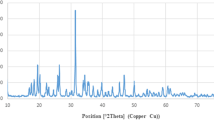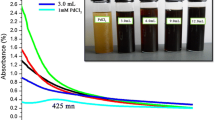Abstract
The treatment of cancer often leads to a range of adverse effects. Encapsulating drugs can mitigate these effects and enhance drug efficacy by enabling a controlled release at the site of interest. This study details the successful synthesis of zinc oxide nanoparticles (ZnONPs) through the precipitation of Zn(NO3)2·6H2O with KOH. A Pd(II) complex drug was synthesized from a Schiff base ligand derived from 2-hydroxybenzohydrazide and (E)-1-(2-(p-tolyl)hydrazono)propan-2-one using potassium tetrachloropalladate(II). This complex was subsequently incorporated into ZnONPs. Characterization of the resulting compounds was performed using Transmission Electron Microscopy (TEM), Dynamic Light Scattering (DLS), Zeta Potential, Fourier Transform Infrared (FTIR) Spectroscopy, and UV-visible spectroscopy. TEM imaging revealed particle sizes of 160.69 ± 4.74 nm for ZnONPs and 185.28 ± 2.3 nm for the Pd(II) complex-encapsulated ZnONPs. The Zeta potential values were 6.53 mV for ZnONPs and 7.36 mV for Pd(II) complex-encapsulated ZnONPs. UV-visible spectroscopy showed an absorption peak at 360 nm for ZnONPs, while the Pd(II) complex-encapsulated ZnONPs exhibited a peak at 410 nm. FTIR analysis indicated the presence of the Pd(II) complex within the ZnONPs, as evidenced by a consistent Zn-O vibrational band at 832 cm−1 and a shift in another peak from 460 to 413 cm−1. Additionally, the detection of a C = N stretching vibration at 1548 cm-1 and a carbonyl stretch at 1626 cm−1 was observed. The Encapsulation Efficiency (E.E.) of the Pd(II) complex was 97.2%. A drug release experiment conducted at pH 7 showed a steady-state release pattern after 16 h, with a cumulative release of 44.3%. The cytotoxic effects of the Pd(II) complex and its encapsulated form in ZnONPs on the MCF-7 cell line were assessed via MTT test. The Pd(II) complex encapsulated within ZnONPs exhibited decreased toxicity relative to the unencapsulated drug, as evidenced by a higher IC50 value of 418.5 μg/ml. This suggests that the encapsulation facilitates a sustained release, which allows for targeted accumulation within cells. The elevated IC50 value indicates that the drug delivery system may be engineered to modulate the release of the drug in a more controlled manner, potentially resulting in a prolonged release profile rather than an immediate therapeutic impact.








Similar content being viewed by others
References
Ali, A., Phull, A. R., & Zia, M. (2018). Elemental zinc to zinc nanoparticles: Is ZnO NPs crucial for life? Synthesis, toxicological, and environmental concerns. Nanotechnology Reviews, 7(5), 413–441.
Moussawi, R. N., & Patra, D. (2016). Nanoparticle self-assembled grain like curcumin conjugated ZnO: curcumin conjugation enhances removal of perylene, fluoranthene and chrysene by ZnO. Scientific Reports, 6(1), 1–13.
Rasmussen, J. W., Martinez, E., Louka, P., & Wingett, D. G. (2010). Zinc oxide nanoparticles for selective destruction of tumor cells and potential for drug delivery applications. Expert opinion on drug delivery, 7(9), 1063–1077.
Qu, F., & Morais, P. C. (2001). The pH dependence of the surface charge density in oxide-based semiconductor nanoparticles immersed in aqueous solution. IEEE transactions on magnetics, 37(4), 2654–2656.
Vizirianakis, I. S. (2011). Nanomedicine and personalized medicine toward the application of pharmacotyping in clinical practice to improve drug-delivery outcomes. Nanomedicine: Nanotechnology, Biology and Medicine, 7(1), 11–17.
Xiong, H. M. (2013). ZnO nanoparticles applied to bioimaging and drug delivery. Advanced Materials, 25(37), 5329–5335.
Ambrose, M. A. E. J. (1962). The surface properties of cancer cells: a review. Cancer Research, 22, 525–548.
Vallabhapurapu, S. D., Blanco, V. M., Sulaiman, M. K., Vallabhapurapu, S. L., Chu, Z., Franco, R. S., & Qi, X. (2015). Variation in human cancer cell external phosphatidylserine is regulated by flippase activity and intracellular calcium. Oncotarget, 6(33), 34375.
Kc, B., Paudel, S. N., Rayamajhi, S., Karna, D., Adhikari, S., Shrestha, B. G., & Bisht, G. (2016). Enhanced preferential cytotoxicity through surface modification: synthesis, characterization and comparative in vitro evaluation of TritonX-100 modified and unmodified zinc oxide nanoparticles in human breast cancer cell (MDA-MB-231). Chemistry Central Journal, 10(1), 1–10.
Erathodiyil, N., & Ying, J. Y. (2011). Functionalization of inorganic nanoparticles for bioimaging applications. Accounts of chemical research, 44(10), 925–935.
Beletsi, A., Klepetsanis, P., Ithakissios, D. S., Kounias, S., Stavropoulos, A., & Avgoustakis, K. (2008). Simultaneous optimization of cisplatin-loaded PLGA-mPEG nanoparticles with regard to their size and drug encapsulation. Current Nanoscience, 4(2), 173–178.
Gryparis, E. C., Mattheolabakis, G., Bikiaris, D., & Avgoustakis, K. (2007). Effect of conditions of preparation on the size and encapsulation properties of PLGA-mPEG nanoparticles of cisplatin. Drug Delivery, 14(6), 371–380.
Fahmy, H. M., Mosleh, A. M., El-Sayed, A. A., & El-Sherif, A. A. (2023). Novel palladium (II) and Zinc (II) Schiff base complexes: Synthesis, biophysical studies, and anticancer activity investigation. Journal of Trace Elements in Medicine and Biology, 79, 127236.
Hadizadeh, S., Najafzadeh, N., Mazani, M., Amani, M., Mansouri-Torshizi, H., & Niapour, A. (2014). Cytotoxic effects of newly synthesized palladium (II) complexes of diethyldithiocarbamate on gastrointestinal cancer cell lines. Biochemistry Research International, 2014, 813457.
Deng, Y., & Zhang, H. (2013). The synergistic effect and mechanism of doxorubicin ZnO nanocomplexes as a multimodal agent integrating diverse anticancer therapeutics. International Journal of Nanomedicine, 8, 1835.
Abayarathne, H. M. I., Dunuweera, S. P., & Rajapakse, R. M. G. (2020). Synthesis of cisplatin encapsulated Zinc oxide nanoparticles and their application as a carrier in targeted drug delivery. Ceylon Journal of Science, 49(1), 71–79.
Jiang, J., Oberdörster, G., & Biswas, P. (2009). Characterization of size, surface charge, and agglomeration state of nanoparticle dispersions for toxicological studies. Journal of Nanoparticle Research, 11(1), 77–89.
Bussereau, F., Benejean, J., & Saghi, N. (1982). Isolation and study of temperature-sensitive mutants of rabies virus. Journal of General Virology, 60(1), 153–158.
Murdock, R. C., Braydich-Stolle, L., Schrand, A. M., Schlager, J. J., & Hussain, S. M. (2008). Characterization of nanomaterial dispersion in solution prior to in vitro exposure using dynamic light scattering technique. Toxicological sciences, 101(2), 239–253.
Chieng, B. W., & Loo, Y. Y. (2012). Synthesis of ZnO nanoparticles by modified polyol method. Materials Letters, 73, 78–82.
Rajbongshi, H., Bhattacharjee, S., & Datta, P. (2017). Photocatalytic activity of Ag/ZnO core–shell nanoparticles with shell thickness as controlling parameter under green environment. Materials Research Express, 4(2), 025501.
Nagaraju, G., Prashanth, S. A., Shastri, M., Yathish, K. V., Anupama, C., & Rangappa, D. (2017). Electrochemical heavy metal detection, photocatalytic, photoluminescence, biodiesel production and antibacterial activities of Ag–ZnO nanomaterial. Materials Research Bulletin, 94, 54–63.
Babu, K. S., Reddy, A. R., Sujatha, C., Reddy, K. V., & Mallika, A. N. (2013). Synthesis and optical characterization of porous ZnO. Journal of Advanced Ceramics, 2(3), 260–265.
Sathisha, M. P., Revankar, V. K., & Pai, K. S. R. (2008). Synthesis, structure, electrochemistry, and spectral characterization of bis-isatin thiocarbohydrazone metal complexes and their antitumor activity against Ehrlich ascites carcinoma in Swiss albino mice. Metal-Based Drugs, 2008, 362105.
Srinivasan, S., Athappan, P., & Rajagopal, G. (2001). Synthesis, spectral and redox properties of metal complexes of macrocyclic tetraaza chiral Schiff bases. Transition Metal Chemistry, 26(4), 588–593.
Da Silva, C. G., Rueda, F., Löwik, C. W., Ossendorp, F., & Cruz, L. J. (2016). Combinatorial prospects of nano-targeted chemoimmunotherapy. Biomaterials, 83, 308–320.
Basotra, M., Singh, S. K., & Gulati, M. (2013). Development and validation of a simple and sensitive spectrometric method for estimation of cisplatin hydrochloride in tablet dosage forms: Application to dissolution studies. International Scholarly Research Notices, 2013, 936254.
Jomeh Farsangi, Z., Rezayat, S. M., Beitollahi, A., Sarkar, S., Jaafari, M., & Amani, A. (2016). Hollow Mesoporous Silica Nanoparticles (HMSNs) Synthesis and in vitro Evaluation of Cisplatin Delivery. Journal of Nanoanalysis, 3(3), 120–127.
Shinde, V. R., Revi, N., Murugappan, S., Singh, S. P., & Rengan, A. K. (2022). Enhanced permeability and retention effect: A key facilitator for solid tumor targeting by nanoparticles. Photodiagnosis and Photodynamic Therapy, 39, 102915.
Alasvand, N., Urbanska, A. M., Rahmati, M., Saeidifar, M., Gungor-Ozkerim, P. S., Sefat, F. & Mozafari, M. (2017). Therapeutic nanoparticles for targeted delivery of anticancer drugs. Multifunctional systems for combined delivery, biosensing and diagnostics, 245−259.
Author information
Authors and Affiliations
Contributions
H.M.F. designed this study, and all authors wrote the primary manuscript, conducted experiments, and generated Figs. All contributors evaluated the manuscript. All contributors reviewed and approved the manuscript.
Corresponding author
Ethics declarations
Conflict of Interest
The authors declare no competing interests.
Additional information
Publisher’s note Springer Nature remains neutral with regard to jurisdictional claims in published maps and institutional affiliations.
Rights and permissions
Springer Nature or its licensor (e.g. a society or other partner) holds exclusive rights to this article under a publishing agreement with the author(s) or other rightsholder(s); author self-archiving of the accepted manuscript version of this article is solely governed by the terms of such publishing agreement and applicable law.
About this article
Cite this article
Mosleh, A.M., El-Sherif, A.A., El-Sayed, A.A. et al. Characterization and Cytotoxicity Assessment of Synthesized Palladium (II) Complex-Encapsulated Zinc Oxide Nanoparticles for Cancer Treatment. Cell Biochem Biophys (2024). https://doi.org/10.1007/s12013-024-01273-1
Accepted:
Published:
DOI: https://doi.org/10.1007/s12013-024-01273-1




